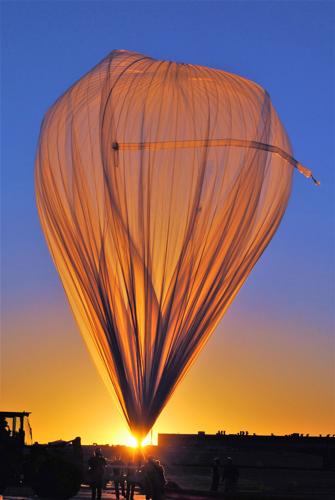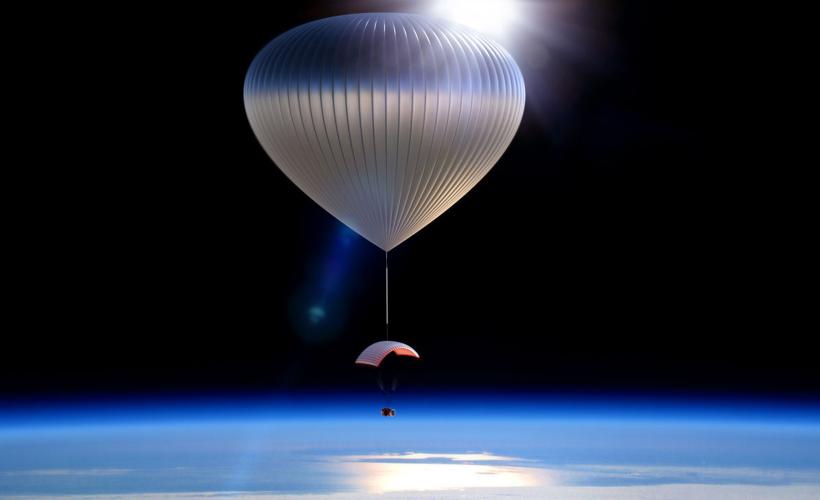The creation of a “spaceport” south of Tucson International Airport has won broad political and business support as a potential driver of local economic development.
But a recent meeting of the Tucson Airport Authority board raised some questions and concerns from airport stakeholders — including initial opposition from one of the airport’s biggest airline carriers.
Pima County is developing the spaceport site, about a mile and a half southwest of Tucson International Airport’s main runway, and is already constructing a building for World View to lease for balloon manufacturing and payload preparation. The county owns the property and building and will lease it to World View, which will also manage the launch pad under contract to the county.
World View is in a pre-application process with the Federal Aviation Administration for licenses to operate a launch site and commercial manned vehicles.
At a Tucson Airport Authority board study session Wednesday, World View principals Jayne Poynter and Taber MacCallum explained the company’s plans for Spaceport Tucson and asked the TAA board for a resolution of support.
World View set several records for a high-altitude human jump when it flew Google executive Alan Eustace to the stratosphere and back in 2014.
The company intends to eventually offer human flights as part of the “experience market,” but it already is running a commercial business launching “stratollites” — small vehicles that can loiter over the Earth’s atmosphere for days or months at a fraction of the cost of an orbiting space satellite.
The company already has launched more than 50 stratollites for commercial customers from sites such as small regional airports.
“We’re already flying these unmanned systems commercially for various companies and government agencies,” Poynter said, citing customers including NASA, Northrop Grumman and Boeing.
As World View’s plans move forward, the company expects to eventually employ 400 workers, and perhaps more, Poynter said.
If approved, Spaceport Tucson would be the closest to a commercial airport than any of the 10 current FAA-approved space launch sites, with the launch pad about 8,500 feet or 1½ miles from the south end of TIA’s main runway.
MacCallum said the spaceport location is ideal because it will be in clear view of TIA’s new air-traffic control tower, under construction west of the runway and expected to open in 2017.
“It’s really the safest way to do these sites,” he said.
“A lot of our unmanned flights are now done at regional airports where we don’t have the same level of separation services and situational awareness with air-traffic control.”
But that proximity also raised some concerns over how spaceport flights would affect other air operations, which besides commercial air service and general aviation includes daily flights by F-16 fighter jets from the Arizona Air National Guard 162nd Wing at TIA.
MacCallum said World View operations would be merged into TIA’s traffic flow much like any general-aviation flight, typically departing between about 4 a.m. and 7:30 a.m., launching vertically and leaving the airport’s controlled airspace after about four minutes.
World View’s balloon craft are remotely piloted, adjusting ballast as needed to reach winds that track in a desired direction, before being guided to landing in a predesignated, typically remote area.
“We’ll be woven in just like any other general-aviation flight,” MacCallum said.
“I don’t see us being any more of an interruption to the flow than other flights … it’s a very controlled process, when we release into the flow.”
MacCallum said the company will continue to launch from various sites, perhaps averaging one per week from Spaceport Tucson once operations begin here.
But some participants in the nearly two-hour TAA study session were leery.
An official of Southwest Airlines said the airline — TIA’s biggest passenger carrier until the recent merger of American and US Airways — is opposed to the spaceport.
“This may be a great opportunity, but putting it next to a commercial airport is a terrible idea,” said Perry Clausen, manager of air-traffic systems for Southwest Airlines’ flight operations.
“It erodes safety and erodes the commercial attractiveness of the Tucson airport.”
Joe Hughes, regional director of government affairs for American Airlines, said most participants share the same goals in assuring safe operations, but the airlines’ input is important.
“I think we’re all on the same page, we just need to sit at the same table,” Hughes said.
Stacy Howard, regional representative for the National Business Aviation Association, said her organization is especially concerned about the retrieval of the used balloons.
“The launch process doesn’t sound duly restrictive,” Howard said. “We’re more concerned with the retrieval process, and the large gas balloons descending back to Earth and how that might affect traffic.”
Poynter noted that similar balloons have been flown for years without incident. MacCallum said both the balloons and the vehicles they propel are equipped with the latest transponders and are tracked until they are recovered, typically in a remote area.
The board asked World View to gather more input from airlines and other stakeholders and return for a vote on a supportive resolution on Aug. 3.
TAA President and CEO Bonnie Allin said the airport will be part of the FAA licensing process, which will include airlines as key stakeholders in a process requiring detailed safety and environmental studies under federal law.
“Our concern is to get everyone who has a stake in safe operation of this airport at the table and be part of the process and have their voices be heard,” Allin said.
MacCallum said he recently heard of meetings at the FAA in Washington where Tucson has been portrayed as unsupportive of the spaceport.
The project is the target of a pending lawsuit filed by the Goldwater Institute against Pima County, challenging the use of taxpayer money to finance development of the World View property.
“The appearance is the board is against the spaceport, and that’s damaging to us and damaging to the community,” MacCallum said.
TAA board member Bill Assenmacher said that makes it all the more important to settle any issues and get all airport stakeholders behind the spaceport.
“We want to move the process forward, because what’s at stake here is economic opportunity for the community,” he said.













